Revell 1/48 Spitfire IX/XVI
|
KIT #: |
04554 |
|
PRICE: |
£16-99
(about $27.00) |
|
DECALS: |
Two options |
|
REVIEWER: |
Frank Reynolds |
|
NOTES: |
Rebox of Hasegawa kit |
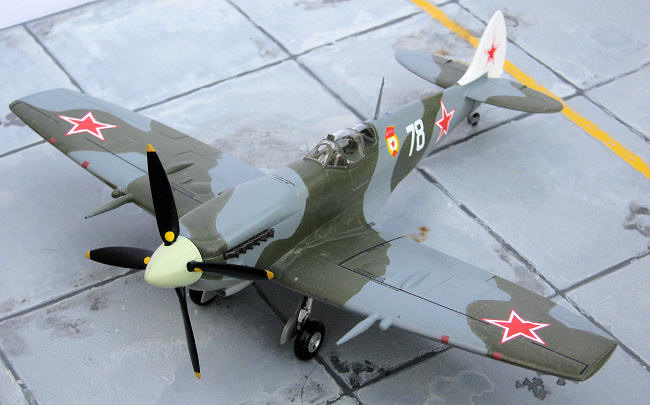
The
Spitfire IX is the most prolific of the Spitfire series, produced in great
numbers and was the most widely exported variant. Many regard it as the purest
and most attractive variant and even in the 21st century it is the
most sought after in the full size warbird market place. In simple terms, the Mk
XVI is a IX fitted with a US-built Packard Merlin engine, but there is a raft of
detail variations between different airframes at different points in the service
history of the type.
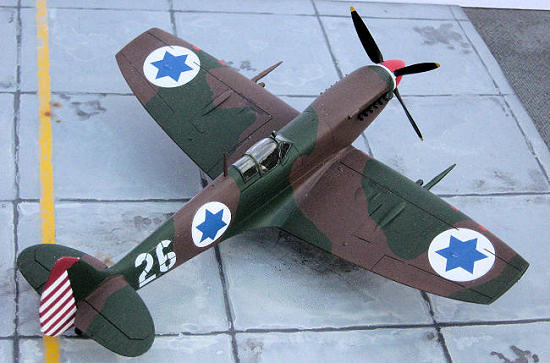 My Spitfire
and Seafire collection in
1:48 scale has gone from representative to near-obsessive
and over the last five years has grown to 48 completed airframes, with no sign
of getting to the end of the line.
In order for the collection to provide a comparative overview of the development
of the line, I have evolved a policy of default kits for the collection. For the
Merlin engined variants:
My Spitfire
and Seafire collection in
1:48 scale has gone from representative to near-obsessive
and over the last five years has grown to 48 completed airframes, with no sign
of getting to the end of the line.
In order for the collection to provide a comparative overview of the development
of the line, I have evolved a policy of default kits for the collection. For the
Merlin engined variants:
Mks I, II,
V & VI – based on the Tamiya Mk1 and MkV
Mks VII,
VIII, IX, X, XI and XVI – based on the Hasegawa VIII/IX
The
Hasegawa 1:48 Spitfire series has been hotly debated many times; there is little
doubt that the fuselage is too short, but in spite of any dimensional flaws - it
works for me, it looks like a Spit IX, it is straightforward to build and I like
its predictable and precise engineering. Revell Europe has re-boxed the Hasegawa
mouldings in its familiar letterbox type end opening box and at a price in the
UK that makes it an absolute bargain. At around £16-99,
as low as £15-00 at some outlets, it is a steal compared with over £30-00 being
charged for the Hasegawa original.
An overall
build and review of the Hasegawa kit is provided by Scott van Aken’s MM
article of March 2007, so I
will confine my comments to an overview of what is in the box and how it relates
to my collection.
The
kit provides five parts frames in crisply moulded medium grey plastic and one
frame of clear for the transparencies, gun sight and wing tip lights.
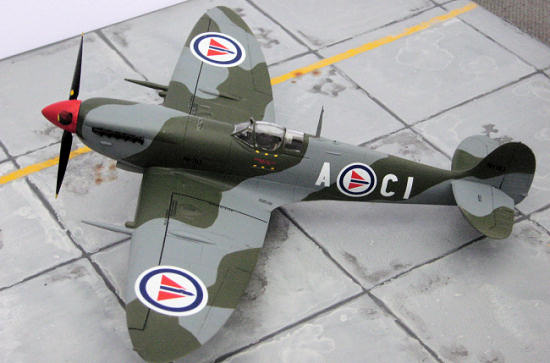 There
are parts for rounded or pointed rudder; standard or clipped wing tips; two
types of exhaust; fixed or retractable tail wheel; under wing bombs; three types
of wheel hub; three types of wing cannon. Not all of these build options are
applicable to the two decal options
offered, but this is ideal for my purposes so I can mix and match my way through
different versions for the World’s air forces.
There
are parts for rounded or pointed rudder; standard or clipped wing tips; two
types of exhaust; fixed or retractable tail wheel; under wing bombs; three types
of wheel hub; three types of wing cannon. Not all of these build options are
applicable to the two decal options
offered, but this is ideal for my purposes so I can mix and match my way through
different versions for the World’s air forces.
The
wing panel inserts allow for an inboard cannon location only, the lower cowl
moulding only offers the late type carburettor air intake and the horizontal
tail planes are of the late type.
On
each of the last six examples of the kit that I have examined there has been
some flash around the four bladed propeller but this is the only visible flaw to
be seen.
I
find that the kit flows together easily, the parts well engineered with only
very minor fit issues requiring no more than a brush over with a sanding stick.
The
neat and crisp decal sheets provides a choice of two finishes for the RAF in
Europe just after the end of World War 2; a Mk IXc of No 43 Sqn and a Mk XVI of
No 308(Polish) Sqn. Both are in the standard camouflage of the period with upper
surfaces of Dark Green and Ocean Grey, lower surfaces of Medium Sea Grey. The IX
has standard wing tips and inboard wing cannon; the XVI has clipped wings and is
drawn showing outboard wing cannon so cannot be built from the kit without
modification to the upper wing panels. The sheet also includes a full set of
stencils, wing walks, instrument panel and seat belts, so even if I intend
changing the colour scheme, this sheet has much if what I need as standard.
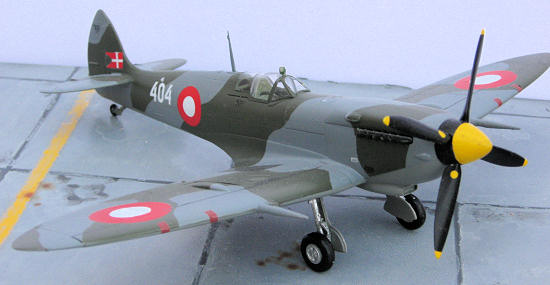 So having a
box of raw material from Revell, I have a reasonably priced and flexible package
to work into my collection. Focussing on the Mk IX as the basis for the widest
variation of users and colour schemes I have evolved a check list of the
characteristics that need to be covered, as follows.
So having a
box of raw material from Revell, I have a reasonably priced and flexible package
to work into my collection. Focussing on the Mk IX as the basis for the widest
variation of users and colour schemes I have evolved a check list of the
characteristics that need to be covered, as follows.
Wing
tips – standard elliptical or clipped.
Horizontal
tail – standard type or later version with enlarged horn balance.
Rudder –
rounded or pointed tip.
Wing cannon
fairing – three types, large early bulged fairing, late skinny type with either
inboard or outboard cannon location.
Carburettor
air intake under chin cowling – early small type or later enlarged filer type.
Underwing/fuselage
bombs.
Wheel hub
pattern.
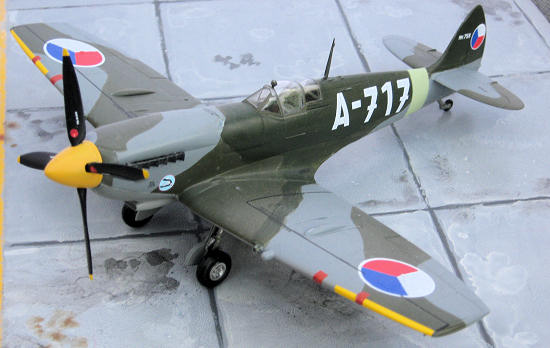 Good
reference sources are essential, preferably backed
up with photographic evidence, but with over 24,000 Spitfires and
Seafires built and about 30 military air arms using the types, a bit of inspired
guesswork and logical deduction is necessary.
Good
reference sources are essential, preferably backed
up with photographic evidence, but with over 24,000 Spitfires and
Seafires built and about 30 military air arms using the types, a bit of inspired
guesswork and logical deduction is necessary.
With
such a popular subject, there is an extensive range of aftermarket parts and
accessories available and many decal sheets.
My
current collection includes eight variations on this very good Revell/Hasegawa
package: The most common modification required is the replacement as necessary
of the covers over the upper wing cannon bays with either the large teardrop
type or the skinny type with the bulge in the outer wing position. Injection
moulded replacements have been issued by Aeroclub in the UK in the past or
they are available as a by-product of building a Mk Vc or Seafire from
the Special Hobby range since all three types seem to be included in these kits.
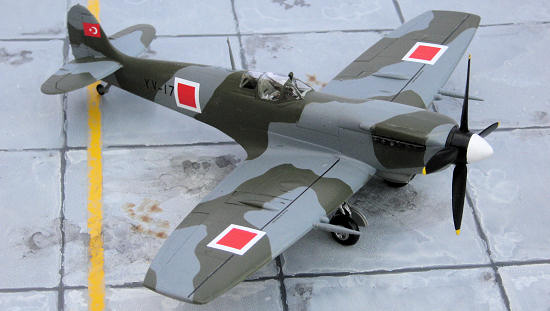 When
finishing I use an undercoat of auto primer applied from a rattle can. For
camouflage colours I always look first to the Xtracrylix range. Primary colours
such as black, white, reds, yellows and silvers come from the Tamiya Color
range. All applied with my trusty Iwata HP-C airbrush. After a gentle pass over
the paint finish with an ultra fine sanding stick, two coats of Future/Kleer
provide a base for the decals, applied with Microsol and Microset as required,
finally sealed with a coat of Xtracrylix varnish
When
finishing I use an undercoat of auto primer applied from a rattle can. For
camouflage colours I always look first to the Xtracrylix range. Primary colours
such as black, white, reds, yellows and silvers come from the Tamiya Color
range. All applied with my trusty Iwata HP-C airbrush. After a gentle pass over
the paint finish with an ultra fine sanding stick, two coats of Future/Kleer
provide a base for the decals, applied with Microsol and Microset as required,
finally sealed with a coat of Xtracrylix varnish
Shown in various locations within this article are Spitfires
from :
Czechoslovakia
“A-717” LF MkIXc, 1947-48. Tally Ho Decals 48041 “Spitfires Mk.IX Part one”
Denmark
“41-404” Mk IXe, 4 Squadron 1949. Ventura Decals sheet V4820
Egypt
“664, L” LF IXe, 1 Squadron, 1948.
Techmod Decals sheet 48064
Israel
“26”
LF IXe, 101 Squadron 1949. Techmod Decals sheet 48064
 Italy
“MA617” F IXc, 51 Stormo, Treviso 1947. Italeri decal sheet from their 1:48
Spitfire IX kit no 2651.
Italy
“MA617” F IXc, 51 Stormo, Treviso 1947. Italeri decal sheet from their 1:48
Spitfire IX kit no 2651.
Norway
“A-CI” LF IXe,
332 Sqn, 1948. Ventura Decals sheet V4820
Turkey
“YV-17” LF IXc, 4TH Air Regiment 1950. National insignia from
Turquoise Decals of Turkey, sheet TD002; serial number from Aviaeology Sheet
AOD-48C05
USSR
“78”
Mk IXe, 26 GIAP, Leningrad 1944-45. AML Decals sheet 48 018
All decal sheets are out
of print once they have been made and many of these are not going to be easy to
find.
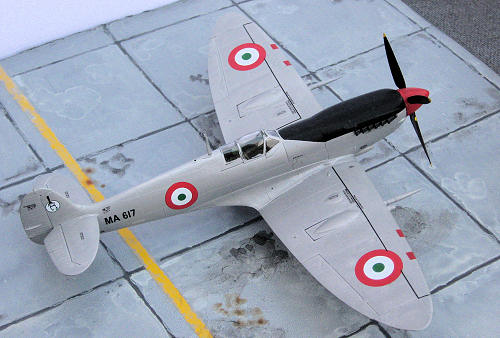 Spitfire
International by Helmut Terbeck, Harry van der Meer and Ray Sturtivant, Air
Britain (Historians) Ltd 2002.
Spitfire
International by Helmut Terbeck, Harry van der Meer and Ray Sturtivant, Air
Britain (Historians) Ltd 2002.
Spitfire,
the History by Eric B. Morgan and Edward Shacklady, Key Publishing, 2000
Frank Reynolds
February 2012
If you would like your product reviewed fairly and fairly quickly, please contact the editor or see other details in the
Note to
Contributors.
Back to the Main Page
Back to the Review
Index Page


 My Spitfire
and Seafire collection in
My Spitfire
and Seafire collection in 
 So having a
box of raw material from Revell, I have a reasonably priced and flexible package
to work into my collection. Focussing on the Mk IX as the basis for the widest
variation of users and colour schemes I have evolved a check list of the
characteristics that need to be covered, as follows.
So having a
box of raw material from Revell, I have a reasonably priced and flexible package
to work into my collection. Focussing on the Mk IX as the basis for the widest
variation of users and colour schemes I have evolved a check list of the
characteristics that need to be covered, as follows. Good
reference sources are essential, preferably backed
up with photographic evidence, but with over 24,000 Spitfires and
Seafires built and about 30 military air arms using the types, a bit of inspired
guesswork and logical deduction is necessary.
Good
reference sources are essential, preferably backed
up with photographic evidence, but with over 24,000 Spitfires and
Seafires built and about 30 military air arms using the types, a bit of inspired
guesswork and logical deduction is necessary. When
finishing I use an undercoat of auto primer applied from a rattle can. For
camouflage colours I always look first to the Xtracrylix range. Primary colours
such as black, white, reds, yellows and silvers come from the Tamiya Color
range. All applied with my trusty Iwata HP-C airbrush. After a gentle pass over
the paint finish with an ultra fine sanding stick, two coats of Future/Kleer
provide a base for the decals, applied with Microsol and Microset as required,
finally sealed with a coat of Xtracrylix varnish
When
finishing I use an undercoat of auto primer applied from a rattle can. For
camouflage colours I always look first to the Xtracrylix range. Primary colours
such as black, white, reds, yellows and silvers come from the Tamiya Color
range. All applied with my trusty Iwata HP-C airbrush. After a gentle pass over
the paint finish with an ultra fine sanding stick, two coats of Future/Kleer
provide a base for the decals, applied with Microsol and Microset as required,
finally sealed with a coat of Xtracrylix varnish Italy
Italy